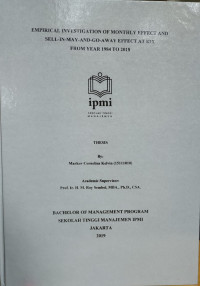
Empirical Investigation of Monthly Effect and Sell-in-May-and-Go-Away Effect at Idx From Year 1984 to 2018
| Gmd : Text
| Availability :
| 2019CS153 | CS/153 | IPMI Kalibata (Thesis S1) | Available |
The topic of this research is essential because investors need to know the right time to enter and exit the stock market. This thesis investigates the Monthly Effect and Sell-in-May-and-Go-Away Effect on IHSG Return. The object of the research is the IHSG monthly return from the period of 1984 to 2018. There are 12 independent variables (months) and 1 dependent variable (IHSG Return). The objectives of this research are: (1) to describe the behavior of monthly return data of IDX market, (2) to investigate the market inefficiency of the Month-of-the Year effect calendar anomaly, (3) to investigate the Sell-In-May-And-Go-Away (SIMAGA) anomaly, and (4) to find a better month-by-month market timing strategy to enter and exit the IDX market. The results of this research explain that for the last 35 years from (1984 to 2018), the months of August, September, and October have the lowest average return and the months that have the highest average return are December, January, and May. The results also show that the Month-of-the-Year anomaly exists in Indonesia Stock Exchange. Also, the Sell-In-May-And-Go-Away strategy is profitable, however the better (more profitable and better Sharpe ratio) strategies are Sell-In-August-Buy-In-November (SIABIN) and Sell-In-August-Buy-In December (SIABID). This result is different from Bouman and Jacobsen (2002) and Twin (2008).
Keywords: Sell-In-May-And-Go-Away, Monthly Effect, IHSG Return, Efficient Market
| Series Title |
-
|
|---|---|
| Call Number |
CS/153
|
| Publisher Place | Jakarta Selatan |
| Collation |
ix, 66p; 30 cm
|
| Language |
English
|
| ISBN/ISSN |
-
|
| Classification |
CS/153
|
| Media Type |
-
|
|---|---|
| Carrier Type |
-
|
| Edition |
-
|
| Subject(s) | |
| Specific Info |
-
|
| Statement |
-
|
| Content Type |
-
|
No other version available







